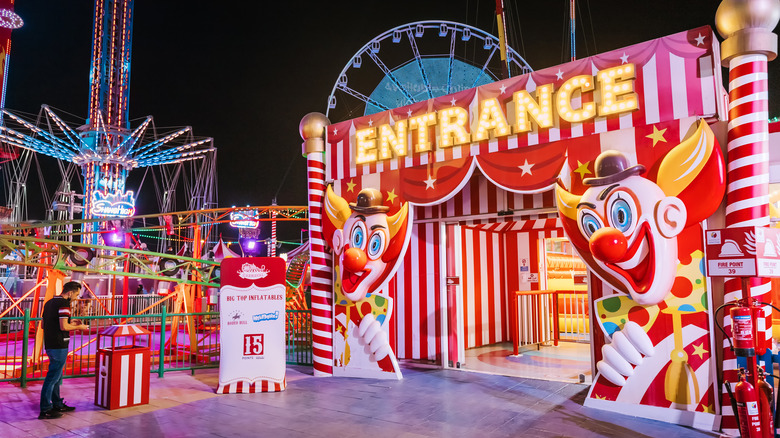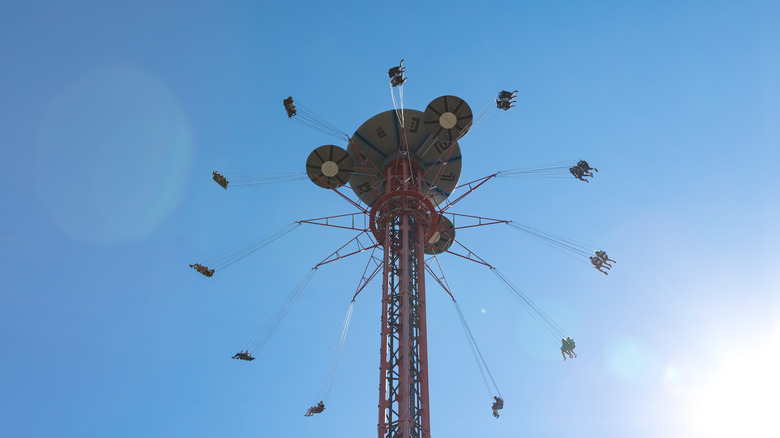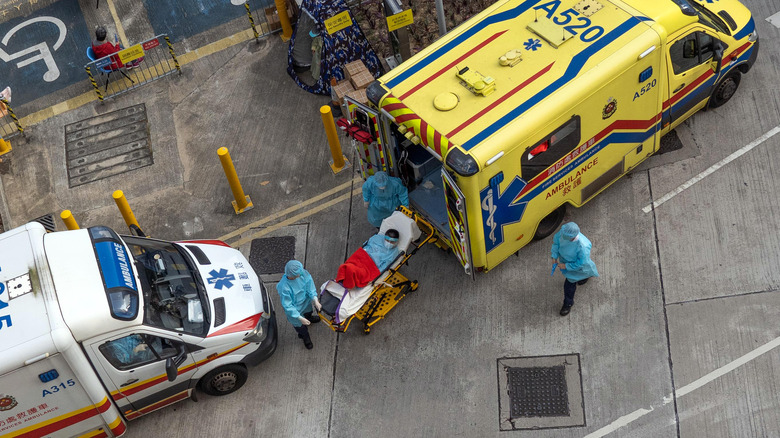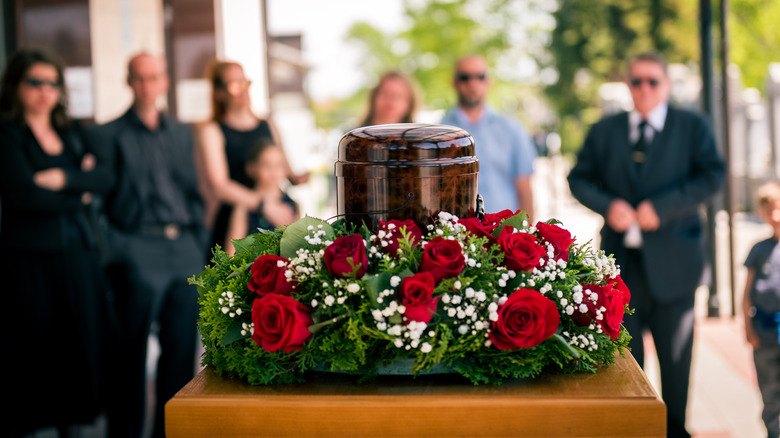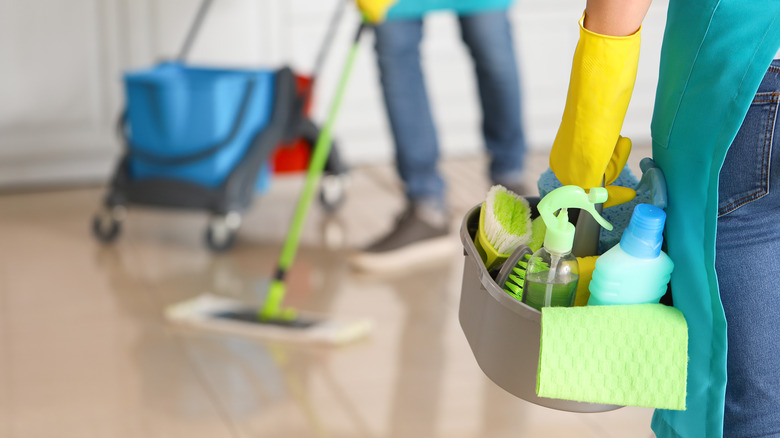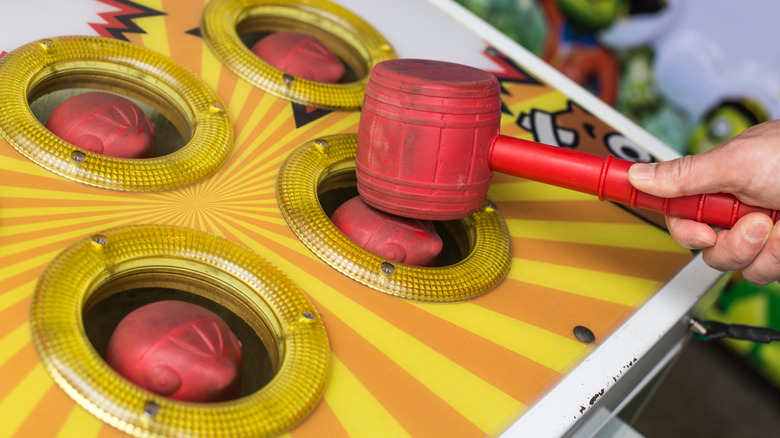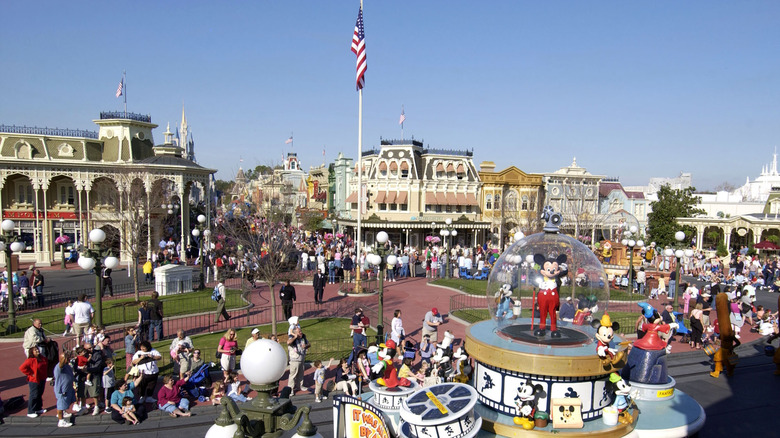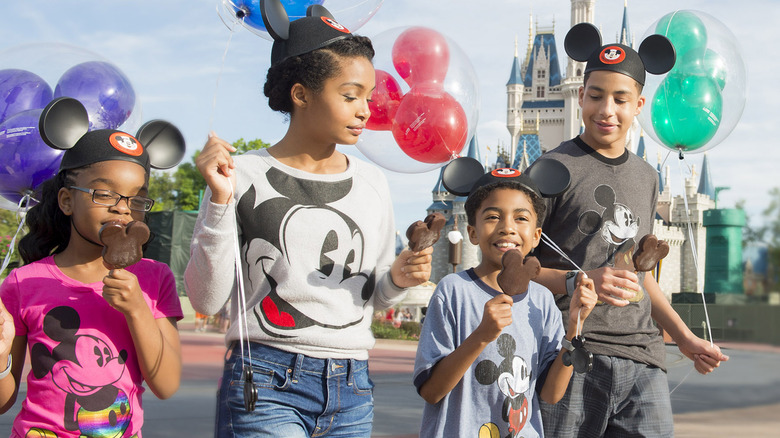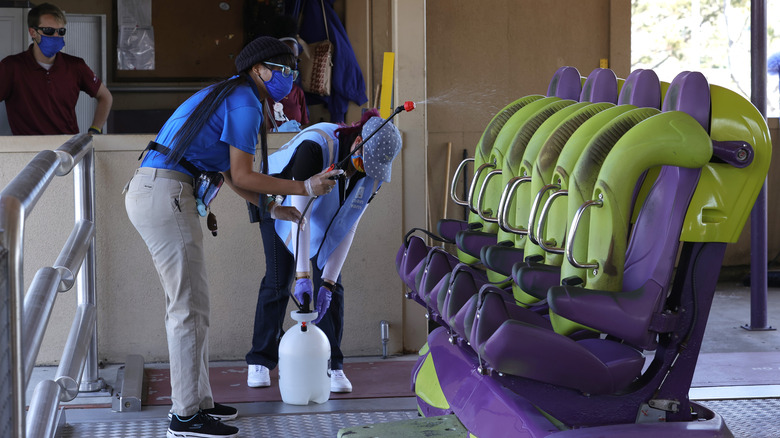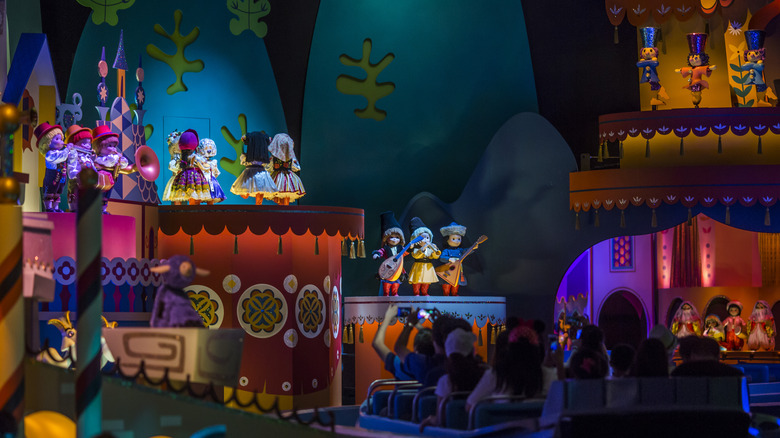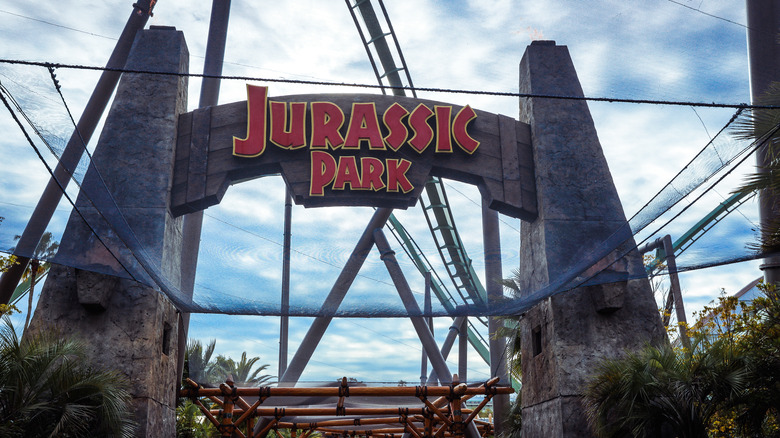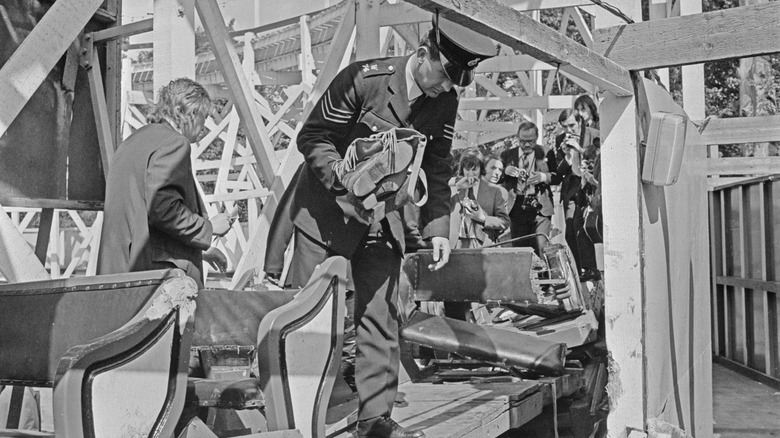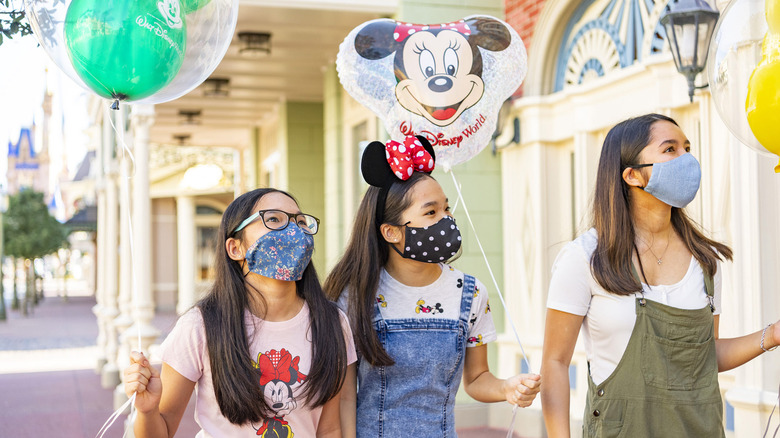Dark Secrets Of Theme Parks Revealed
Call it a theme park, an amusement park, a carnival, a funfair, or what have you, but these ride, game, snack, and other attraction-filled spots have been thrilling people for hundreds of years. The theme park of today, with places like Disney World or a Six Flags location being notable standard bearers, can trace its roots back to the Middle Ages. According to History Today, from the year 1133 A.D. all the way into the 1850s, the annual Bartholomew's Fair was a major draw for Brits from far and wide. It began as a collection of singers, jugglers, and other such minor spectacles, but over the years (or over the centuries, to be more accurate) rides like swings and boat rides were added to the roster.
In America, theme parks began to crop up in earnest in the latter years of the 19th century, according to History. These included New York City's famous (and still extant) Coney Island, Utah's beloved Saltair — a favorite with Salt Lake City area residents, especially Mormons, until it partially burned down in the 1920s — and Ohio's Cedar Point, which opened in 1870, added a roller coaster in 1892, and is considered a roller coaster hotspot to this day, per Glenwood Caverns. Long story short, amusement parks have been amusing people for a long time.
With all that history, though, naturally there plenty of less-than-fun-filled parts of the funfair story. Here are 12 dark theme park secrets.
Thousands of people are injured at amusement parks each year
Remember back in the year 1999 when famed Italian model, Romance novel cover mainstay, and actor Fabio was injured by a goose strike to the face while riding in the front car of a rollercoaster? His bleeding face was all over the news, according to People, and the incident became fodder for late night TV show host monologues, for tabloid newspaper headlines, and later for internet memes. Here's the thing, though: when you think about it objectively, not through the lens of the "I Can't Believe It's Not Butter" pitchman, the incident was no laughing matter. A person was hurt and bloodied by a freak accident that occurred on a ride meant to be all about fun.
And what's more, injurious accidents happen all the time at amusement parks. According to a report issued in October 2020 buy the National Safety Council Research Group called the "IAAPA RIDE SAFETY REPORT," in North America alone, usually between 1,200 and 2,000 ride-related injuries occurred annually at theme parks. This data, it must be noted, pertains only to fixed-site amusement park rides, such as you might find at Disneyland, not to mobile rides such as would be found at a traveling carnival. Overall, the ratios of injuries per riders are quite low when considering the totality of people who are injured on amusement park rides annually, but in either case (fixed or mobile rides) this data only included reported and cataloged injuries, so the numbers are surely higher. (Also, factor in reduced safety standards in many areas outside North America, per an article in Safety Science.)
Theme park deaths are rare in America, but more common overseas
According to a Kansas City Star report published via EMS1, it's pretty unlikely that you'll die as a result of a ride accident in the United States of America. In fact, the International Association of Amusement Parks and Attractions figure the report cites is a one-in-750-million chance of death on an American theme park ride. For a bit of perspective, PETA cites a one-in-3.7-million chance of being killed in an unprovoked shark attack. It does happen — last year, a woman died after a roller coaster injury in Indiana and a child perished after a boat overturned on a water-based ride in Iowa — but it's not likely here.
Now, if you venture out to an amusement park beyond the borders of the United States, in many places, the chances of dying as a result of an amusement park ride accident goes up considerably. Complex reports on an accident that left two dead and more than two dozen injured when a ride failed at an Indian theme park in 2019. Six people were killed in one incident in 2010 at the Overseas Chinese Town East theme park in Shenzhen, China, according to China Daily. There have been multiple deaths caused by rides in Great Britain, including a child killed by a rollercoaster, as reported by the BBC in 2001, a woman who died after carriages on a "Treetop Twister" ride collided that same year, and a girl killed in a Ferris wheel fall in 2002; that's naming just a few incidents in the U.K., which mirror those in Europe and beyond.
People regularly scatter human remains at Disney rides
For many people, Disneyland really does live up to its slogan, per Inside the Magic, of being "The Happiest Place on Earth." (Note that technically Disney World is "The Most Magical Place in Earth" while, according to stats cited by the BBC, Finland is actually the happiest place on earth, being ranked the happiest nation yet again last year.) Thus it's perhaps understandable — if a bit macabre — that many people would wish to stay on at Disneyland or Disney World even after death, a wish often granted by survivors of the deceased. According to the Wall Street Journal, Disney theme parks are commonly the illicit final resting place for scattered human ashes.
And in fact, the practice of scattering human ashes at Disney World and Disneyland is so commonplace — against company policy and also outright illegal as it may be to do so — that Disney employees even have a go-to code term to inform one another of a remains-related incident needing attendance. That term, as related via Ripley's, is "HEPA cleanup." The fact that there is a go-to term for mitigating this issue makes clear how commonly it happen, which is as much as once per month, per the WSJ, but it may hopefully dissuade others from trying to scatter ashes at Disney in the future. If they have an operation in place to clean up ashes, then there's a good chance the ashes won't rest peacefully among the rides and cotton candy and costume characters and such anyway.
Rides are usually shut down for vomit or guest behavior issues
Employees of theme parks have taken to Reddit chat forums to reveal some pretty nasty truths about theme parks. One of them is the fact that, more often than not, if a ride is temporarily closed down, it's not because of any mechanical issue with the hardware itself, but rather because of bodily fluids (or solids) or a guest's misbehavior. One person, who identified as a former Six Flags employee, said that usually rides at his former place of employment were shut down because of vomit.
But another common reason rides are shut down is because of guests who lose items and then demand the ride operators help them retrieve their possessions. One former amusement park ride operator recounted a story of a serviceman demanding a ride be stopped so he could recover a lost military ID card. Dropped phones are another very common reason for temporary ride shutdowns. And then another former employee cited something with which many people identified: rides stopped due to lost glasses. "I couldn't tell you how many times I had to lock out-tag out a ride because some kid lost their glasses on the ride and because its an 'essential item' we had to go look for it," the person said.
On the bright side, the fact that rides go offline for dropped glasses or vomit more often than mechanical failure is reassuring, safety-wise.
Park games are all winnable, just very hard
Theme park and carnival games are notoriously hard to win. Be it a ring toss, a basketball free throw challenge, a target practice shooting game, or what have you, it's no easy feat to get the high score and walk away with a huge novelty stuffed panda or teddy bear or whatever other prize you choose. But it's not impossible to win — contrary to popular misconception, amusement park games are not rigged to be unbeatable. They are, however, designed to be very hard to win, but according to theme park workers quoted in a Business Insider article, the operators actually do want you to win. Just not to win too many times.
What's more, a carnival worker quoted in the Chicago Tribune warned that the better the prizes, the lower your chances of winning. "Look at the prize," the carnival worker said, adding: "If the prize is a huge stuffed animal, you can bet it's a difficult game. Carnies aren't throwing out those prizes regularly. People should never play for money, or never play for anything that's truly valuable [like] gold or a TV set. That's a real good tip-off the game is rigged."
Disney flies fake American flags
Walk through the gates (well, wait in a long line and then pass through the security checkpoints and have your ticket or "Magic Band" scanned and then walk through the gates) of a Disney theme park and you'll step onto Main Street USA, the first and primary thoroughfare of a Disney park. Main Street USA leads to the famed castle (Cinderella Castle at Disney World and Sleeping Beauty Castle at Disneyland), and it's the site of daily parades, it's lined by shops and eateries, and it is, as the name and theme suggests, appropriately lined with lots and lots of flags. But note of the pains not to say "American flags," for indeed the The Walt Disney Company has taken pains to ensure the many flags lining Main Street USA are not technically American flags. The Main Street USA flags look like the good old Stars and Stripes, but look closer and you'll see each will be a star or two shy of 50 or will be missing a stripe (via AllEars).
Why does Disney fly fake American flags? Because, according to a former cast member on Military Disney Tips, it would be a serious pain to have to take each and every flag down every evening and raise it again in the morning, but that's what would be legally required were the flags real. Per Cornell Law School, the law 4 U.S. Code § 6 states: "It is the universal custom to display the flag only from sunrise to sunset on buildings and on stationary flagstaffs in the open. However, when a patriotic effect is desired, the flag may be displayed twenty-four hours a day if properly illuminated during the hours of darkness."
Imitation flags, however, can fly day or night, rain or shine.
Food and beverage markups are massive
Granted, you know that going into any establishment that sells food means you'll be paying a markup. Grocery stores have to charge you more than they paid the farmer (or abattoir or rancher or distributor) for the foods they sell, restaurants further mark up food costs because of labor, and so forth. But the degree of price markups theme parks tend to apply to food is so high it will shock you, even when a markup is expected. According to an opinion post and subsequent discussion thread shared in Theme Park Insider, food and beverage prices are often elevated by a factor of three or even four times at amusement parks like Six Flags, Disney, or Universal.
The main Theme Park Insider article cites $7 pizza slices at Disney, while entire pizza pies can be had for a bit less than $10 when bought elsewhere. It references $3.50 charged for a 12-ounce soda that would be all of $1 at a store. And on it goes. Again, price hikes are to be expected, but the callous calculation behind them is not. The team working out pricing knows that at $1, they may sell lots of sodas, whereas by the time the price hits, say, $3.50, they may sell many fewer. But do the math: sell 100 sodas at $1 and you only make $100. Sell only 60 sodas at $3.50 and you make $210, so whereas unit sales fall by nearly half, revenues more than double. And so what if some park goers are left thirsty or hungry and a bit off put?
Rides are rarely sterilized, merely cleaned visually
Fair warning for the faint of heart germ-wise: theme park rides are very dirty. Not as in filled with trash or covered with dirt or anything so obvious as that, but as in there are billions and billions of microorganisms all over everything from roller coaster seatbelts and harnesses to benches and tables and so forth, according to Cheat Sheet. It's those rides themselves that are the potentially most germ-laden spots in the park, because with rides constantly operating during park open hours and without time to clean the surfaces into which riders are strapped, the germs just sit there, their numbers growing all day long. Theme park employees sharing insights in a Reddit thread revealed that surfaces of rides are almost never sterilized and may at best be quickly wiped down.
Shockingly (and rather disgustingly) this is often even true in the case of vomit. When a person throws up on a ride, the workers will usually spread sawdust over the regurgitated material to absorb the fluids and make the solids easier to remove, scoop and sweep up the mess, and then rinse away the remains of the vomit and sawdust (or similar absorbent substance) with water alone. There are exceptions, of course — some theme park employees reported prompt and thorough clean up and disinfecting of all bodiy fluids — but in most cases, it's best to assume the worst and plan to at least wash and sanitize your hands often.
The figures in It's a Small World never stop moving
The "It's a Small World" rides are some of the most iconic attractions at Disney theme parks. Beloved by most and absolutely loathed by others, primarily for the infectious eponymous song in the latter case, according to Popsugar, this classic ride has been running at Disneyland since the mid 1960s and at Disney World since that park opened in 1971. (There is also an "It's a Small World" ride at Disney parks in Tokyo, Paris, and Hong Kong.) As guests slowly drift along in little boats that pass through various rooms representing nations, regions, and cultures of the world, they are greeted by more than 300 animatronic figurines that dance, wave, and whirl to the music.
And if we are to believe a New York Post article citing a viral TikTok video, those figurines keep on dancing, waving, and whirling even in the dark dead of night. That's right, the "It's a Small World" figures never stop moving. The speculation is that because these figures are kept in motion by hydraulic pressure, to stop their movement would necessitate reducing the pressure throughout large interconnected systems of pumps and tubes each night when the ride closed down, and then re-pressurizing them in the morning, so it's easier and more effective to just let them run endlessly. The music stops, the lights go down, and the boats stop running, but the little figures keep wriggling all night long.
Universal's Jurassic Park ride cost $110 million
Huge theme park attractions are very expensive to construct, but they can pay for themselves many times over in ticket sales. If that sounds like a familiar business model, it is. Movies traditionally made money in just the same way, with the largest, highest budget blockbusters making loads of profit in movie theater ticket sales. (That said, this is "traditionally," as revenue models are changing as the ways people consume media evolve.) According to IMDb the Steven Spielberg-directed 1993 smash-hit feature film "Jurassic Park" had a budget of $63 million, a stunning sum for the time (and still a lot of money for a movie to cost). The Universal theme park ride inspired by the film, however, would make the movie's budget look like a steal.
When the "Jurassic Park" ride opened at Universal Studios in Studio City, California, in 1996, it cost $110 million to build, according to LAist. That's a price tag that's nearly twice the expense of the movie. And it was, for many years, the most expensive ride ever built, not to mention the ride with the longest water drop, according to RTT News, though the ride has now lost both claims to fame (or infamy, in the case of the cost, perhaps). The "Jurassic Park" ride thrilled fans for 22 years before it was finally shuttered in 2018 to make way for an expanded "Jurassic World" attraction. If Universal Studios saw at least $5 million in ticket sales attributable to the "Jurassic Park" ride in each of those 22 years, then it was worth it.
There have been multiple instances of decapitations at theme parks
As noted, deaths on theme park rides are not common in the United States. And while statistically more probable in other nations, generally, theme park rides are safer than other much more common activities such as driving a vehicle. But when a death does occur at an amusement park, it often happens in truly horrific ways. To that end, note the multiple instances of decapitations that have happened as a result of a theme park ride.
According to The U.S. Sun, in 2016, a young boy of 10 was decapitated while riding on a water slide in Kansas City called "Verruckt," which translates from the German to "Insane" in English. The attraction had been certified as the world's tallest water slide by Guinness World Records. In 1984, a woman's head (and chest) was crushed on the Matterhorn Bobsled ride at Disneyland, according to Snopes. In 2008, a teenager was decapitated by a roller coaster at a Six Flags in Georgia, reports NBC News – though to be clear, he was not riding the attraction at the time, but rather had jumped a fence, violating a restricted area as he tried to retrieve a hat lost while he was on the ride.
The sheer speed and size associated with these rides can be enough for them to turn not only deadly, but grisly.
Theme parks have long been hotbeds for spreading disease
The COVID-19 pandemic changed just about everything about how we do just about everything, and that includes how public safety is addressed at theme parks. With luck, one bit of silver lining to the deadly multi-year nightmare that the pandemic has been will be reduced outbreaks of sicknesses caused by places like theme parks, because before mask wearing and temperature checks and hand sanitization became a part of regular life, amusement parks were hotbeds of disease spread.
According to WebMD, in 2015, a major outbreak of measles could be traced directly to Disney, and to a pair of Disney theme parks in Southern California. BBC News noted multiple cases of horrible stomach and intestinal sickness linked to a pathogen at a water park in 2019. A Los Angeles Times story covered an outbreak of Legionnaire's disease at a Disney park in 2017. Only through stringent safety measures have most major theme parks avoided major COVID-19 outbreaks, and one can only hope that with improved disease prevention protocols staying in place in the future, theme parks will no longer be ripe breeding grounds for viral and bacterial diseases.
